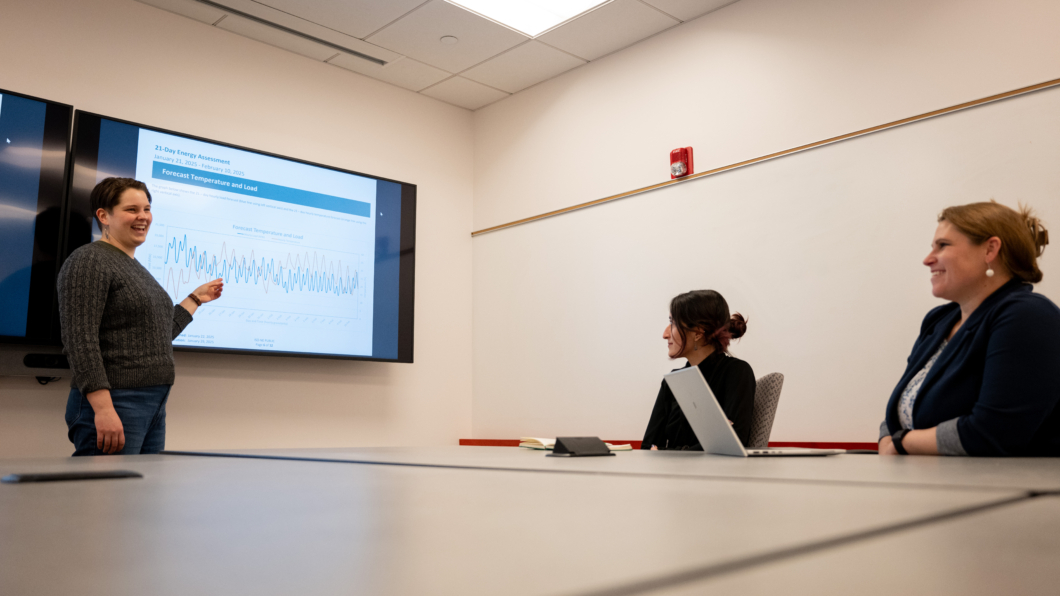Balancing energy security in a changing power system

Imagine, early one winter morning, a cold front moves across New England, increasing demand for both heat and electricity as residents look to stay warm. The cold weather limits natural gas availability for electricity generation. The situation is further complicated when storm clouds move in, casting shadows over solar panels in the region.
Inside ISO New England’s control room, system operators are unfazed. They’ve been preparing for this situation for weeks, thanks to the dedicated team behind the ISO’s 21-day energy forecast.
The Energy Security Analysis team at ISO New England is responsible for evaluating the ability for the region’s resources to meet energy demand across all hours of the day, not just during hours of peak demand.
While meeting peak demand is critical, the proliferation of resources that depend on “just in time” fuel supplies has altered the way organizations like ISO New England think about system reliability.
“Our goal is to analyze data so we understand what the upcoming weeks are going to look like with regard to fuel security in our region, ensuring we keep the lights on, and operate a reliable system,” said Mallory Waldrip, who joined the team in 2021 and is now supervisor of Operations Energy Analytics.
The team’s highest profile product is the rolling three-week energy supply forecast, which evaluates the region’s ability to meet its energy needs. The forecast incorporates key factors like weather, system demand, fuel availability, and expected production from renewable resources.
Published weekly during the winter, the report’s three-week timeline aims to strike a balance between the accuracy of forecasts, allowing sufficient time for the region to take action if issues are anticipated. By proactively communicating, market participants have the opportunity to take stock of their fuel supplies and maintenance schedules.
“Some of the charts in the report are intended to get people to take action,” Waldrip said. “To procure more fuel in the event the report indicates significant stored fuel consumption.”

Increased interest in the assessment, both within the ISO and across the region, has facilitated growth in the team. Hannah Johlas, senior energy security analyst, joined the team in 2022, while Gabriela Alvarez Perez, associate energy security analyst, is the team’s newest hire, joining in 2024.
Alvarez Perez is responsible for pulling together many of the assessment’s individual threads, such as survey responses from generators, transmission outage schedules, and load and weather forecasts. She also has an eye toward improving and enhancing processes.
Johlas’ focus is on longer-term assessments that utilize the tools developed for the 21-day energy assessments. Building on work she did while earning her postdoc at the Massachusetts Institute of Technology, she looks at how New England will meet its energy needs as the region’s clean energy transition plays out.
“Stakeholders are interested in how different resource mixes would have an impact,” Johlas said. “If we retire a certain kind of resource, and bring in more of another, how does that change the energy security balance? Not just in the capacity sense, but in the true energy sense.”
Johlas and Waldrip explained that just because a resource has capacity, it doesn’t mean the resource will always be able to generate the full amount. Weather plays a major role in the output of resources like solar and wind, fuel availability can impact natural gas generation, and things like scheduled maintenance can have an impact as well.

“The basis of our job is to model the entire New England grid, and all of the factors that affect it,” Johlas said. “That’s what I do every day. That’s a very complex thing.”
Adding to the complexities of the future, the team considers things like potential battery storage, policy changes, and weather trends that may impact their future assessments. It’s a lot to account for, and while there’s no way to know exactly how things will play out, ISO New England’s energy security analysts say they have the tools in place to adapt and face the challenges ahead.
“Having a wide mix of skills and backgrounds is important, and we have that on this team—but I also think the mindset of the team is important,” Johlas said. “We’re getting support for the tools as they will continue to adapt and grow, as well as getting better information on the inputs we need to give those tools. All of that is coming from the relationships we are building and fostering now.”
- Categories
- Features & Interviews
- Tags
- system operations
